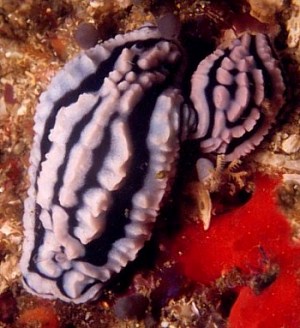Opposites attract even with nudibranchs
October 3, 2001
From: Valda Fraser

Dear Bill
The big Phyllidiella zeylanica selected this small lover. Can't imagine why because there were plenty of large ones about! I thought size would count!
Locality: Park Rynie, south coast KwaZulu-Natal, 25m
Date: September 2001
Regards
Valda
valdafraser@mweb.co.za
Fraser, V., 2001 (Oct 3) Opposites attract even with nudibranchs. [Message in] Sea Slug Forum. Australian Museum, Sydney. Available from http://www.seaslugforum.net/find/5356Dear Valda,
I guess the simple answer is that in these animals 'love is blind'. Basically opisthobranchs are blind. Although they have eyes, they are so simple in construction that they are unable to form images and basically act as light detectors. So body size, and colour, are of little consequence in mate selection. Opisthobranchs seem to operate by smell using chemical detectors (rhinophores etc) and touch (oral tentacles etc). It seems that mate detection can involve the chance discovery of mucus trails but mates are normally discovered by chance 'bumping into each other'. In many species the male organ system matures long before the female system (protandry) so in a case like your phyllidiids it is possible that the smaller may act only as a sperm donor in this exchange. It is also possible that it may receive sperm from its larger partner and store in a sperm sac until its own eggs develop, but this is only speculation as few detailed studies on the function of opisthobranch reproductive systems have been undertaken.
Best wishes,
Bill Rudman
Related messages
-
Re: Phyllidiella meandrina from Mayotte Island
From: Matthias Deuss, November 27, 2009 -
Phyllidiella meandrina from Mayotte Island
From: Matthias Deuss, November 26, 2009 -
Phyllidiella zeylanica from Mayotte Island
From: Matthias Deuss, November 26, 2009 -
Re: Phyllidiella zeylanica from Indian Ocean
From: Sandrine and Hugues Flodrops, March 11, 2009 -
Size differences in mating Phyllidiella zeylanica
From: Colin Ogden, August 30, 2007 -
Phyllidiella zeylanica from Jakarta
From: Charles Rowe, February 7, 2007 -
Phyllidiella zeylanica feeding
From: Lindsay Warren, October 6, 2005 -
Phyllidiella zeylanica from Pemba
From: Paul Young, November 23, 2002 -
Phyllidiella zeylanica? from Pemba
From: Paul Young, November 22, 2002 -
Phyllidiella zeylanica from South Africa
From: Linda Penny, September 16, 2002 -
Phyllidiella zeylanica? from east Africa
From: Bernard Picton , July 2, 2002 -
Phyllidiella zeylanica from Christmas Island
From: Bill Rudman, June 30, 2002 -
Phyllidiella zeylanica from Comoros
From: Valeria Safonova, June 30, 2002 -
Phyllidiella zeylanica from Christmas Island
From: W.B. Rudman, May 13, 2002 -
More pesky Phyllidiids
From: Mary Jane Adams , January 15, 2002 -
Phyllidiella zeylanica? from the Maldives
From: Erwin Koehler, May 27, 2001 -
Phyllidiella zeylanica from Indonesia
From: Yasman, December 31, 2000 -
Phyllidiella zeylanica from Papua New Guinea?
From: Mary Jane Adams, June 7, 2000 -
Phyllidiella zeylanica from Sth Africa
From: Valda Fraser, March 30, 2000 -
Is this Phyllidiella zeylanica?
From: Erwin Koehler, December 14, 1999
